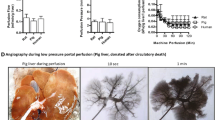Abstract
Hypothermia of the ischemic organ at 4°C protects hepatic microcirculation from ischemia-reperfusion (IR) injury. The effect of hypothermia during ischemia was investigated in animal models using liver transplantation and storage of the harvested organ in cold preservation solutions. No investigation of the isolated influence of hypothermia at 4°C of the ischemic organ on hepatic IR injury exists, due to the lack of an appropriate animal model. Therefore, the aim of our present study was to develop such a model using intravital video fluorescence microscopy (IVM). In C57BL/6 mice, a reversible isolated ischemia of the left liver lobe was induced for 90 min, followed by 240 min of reperfusion. The temperature of the ischemic organ was adjusted to either 4°C or 37°C by superfusion with 0.9% NaCl. Sham-operated animals without IR served as controls. The hepatic microcirculation was analyzed using IVM at 30 min and 240 min after reperfusion by quantifying sinusoidal perfusion and leukocyte-endothelial cell interaction in postsinusoidal venules. At the end of the experiment, blood and tissue samples were taken for measurement of liver enzyme activities and light and electron microscopy. Mean arterial pressure and body temperature were kept constant throughout the experiment, while the temperature of the ischemic liver lobe was adjusted to predefined levels. After normothermic ischemia, hepatic microvascular perfusion was significantly impaired compared with sham-operated animals. Perfusion failure was significantly reduced in hypothermic livers and did not differ from livers of the sham-group. Liver enzyme activities in the normothermic group were significantly higher than in the sham and hypothermic groups. Light and electron microscopy revealed severe histological alterations at 37°C ischemia, whereas at 4°C ischemia only minimal lesions were encountered. Our novel model allows for isolated adjustment of ischemic liver lobe temperature without changing body temperature and systemic macrohemodynamic parameters. Hypothermia at 4°C largely attenuates postischemic microvascular perfusion injury of the liver.
Similar content being viewed by others
Reference
Bilzer M, Gerbes AL (2000) Preservation injury of the liver: mechanisms and novel therapeutic strategies. J Hepatol 32:508–515
Brown MF, Zibari G, Burney D, Granger DN, McDonald JC (1997) Hepatic ischemia/reperfusion affects leukocyte rolling and velocity. Clin Transplant 11:511–515
Clavien PA, Harvey PR, Strasberg SM (1992) Preservation and reperfusion injuries in liver allografts. An overview and synthesis of current studies. Transplantation 53:957–978
Eppihimer MJ, Granger DN (1997) Ischemia/reperfusion-induced leukocyte-endothelial interactions in postcapillary venules. Shock 8:16–25
Horie Y, Wolf R, Flores SC, McCord JM, Epstein CJ, Granger DN (1998) Transgenic mice with increased copper/zinc-superoxide dismutase activity are resistant to hepatic leukostasis and capillary no-reflow after gut ischemia/reperfusion. Circ Res 83:691–696
Jaeschke H (1996) Preservation injury: mechanisms, prevention and consequences. J Hepatol 25:774–780
Kondo T, Okamoto S, Todoroki T, Hirano T, Schildberg FW, Messmer K (1998) Application of a novel method for subsequent evaluation of sinusoids and postsinusoidal venules after ischemia-reperfusion injury of rat liver. Eur Surg Res 30:252–258
Kondo T, Terajima H, Todoroki T, Hirano T, Ito Y, Usia T, Messmer K (1999) Prevention of hepatic ischemia-reperfusion injury by SOD-DIVEMA conjugate. J Surg Res 85:26–36
Kondo T, Todoroki T, Hirano T, Schildberg FW, Messmer K (1998) Impact of ischemia-reperfusion injury on dimensional changes of hepatic microvessels. Res Exp Med (Berl) 198:63–72
Marzi I, Walcher F, Menger M, Buhren V, Harbauer G, Trentz O (1991) Microcirculatory disturbances and leucocyte adherence in transplanted livers after cold storage in Euro-Collins, UW and HTK solutions. Transpl Int 4:45–50
Massberg S, Messmer K (1998) The nature of ischemia/reperfusion injury. Transplant Proc 30:4217–4223
Menger M, Messmer K (1993) Microcirculatory manifestations of hepatic ischemia/ reperfusion injury. In: Messmer K, Menger MD (eds) Liver microcirculation and hepatobiliary function. Karger, Basel, pp 106–124
Menger MD, Richter S, Yamauchi J, Vollmar B (1999) Role of microcirculation in hepatic ischemia/reperfusion injury. Hepatogastroenterology 46 [Suppl 2]:1452–1457
Post S, Palma P, Rentsch M, Gonzalez AP, Menger MD (1993) Differential impact of Carolina rinse and University of Wisconsin solutions on microcirculation, leukocyte adhesion, Kupffer cell activity and biliary excretion after liver transplantation. Hepatology 18:1490–1497
Rauen U, Polzar B, Stephan H, Mannherz HG, de Groot H (1999) Cold-induced apoptosis in cultured hepatocytes and liver endothelial cells: mediation by reactive oxygen species. FASEB J 13:155–168
Schlossberg H, Zhang Y, Dudus L, Engelhardt JF (1996) Expression of c-fos and c-jun during hepatocellular remodeling following ischemia/reperfusion in mouse liver. Hepatology 23:1546–1555
Vollmar B, Menger MD, Glasz J, Leiderer R, Messmer K (1994) Impact of leukocyte-endothelial cell interaction in hepatic ischemia-reperfusion injury. Am J Physiol 267:G786-G793
Wanner GA, Mica L, Wanner-Schmid E, Kolb SA, Hentze H, Trentz O, Ertel W (1999) Inhibition of caspase activity prevents CD95-mediated hepatic microvascular perfusion failure and restores Kupffer cell clearance capacity. FASEB J 13:1239–1248
Zeintl H (1989) Computer assisted leukocyte adhesion measurement in intravital microscopy. Int J Microcirc Clin Exp 8:293–302
Zwacka RM, Zhang Y, Zhou W, Halldorson J, Engelhardt JF (1998) Ischemia/reperfusion injury in the liver of BALB/c mice activates AP-1 and nuclear factor kappaB independently of IkappaB degradation. Hepatology 28:1022–1030
Zwacka RM, Zhou W, Zhang Y, Darby CJ, Dudus L, Halldorson J, Oberley L, Engelhardt JF (1998) Redox gene therapy for ischemia/reperfusion injury of the liver reduces AP1 and NF-kappaB activation. Nat Med 4:698–704
Author information
Authors and Affiliations
Corresponding author
Rights and permissions
About this article
Cite this article
Biberthaler, P., Luchting, B., Massberg, S. et al. Ischemia at 4°C: a novel mouse model to investigate the effect of hypothermia on postischemic hepatic microcirculatory injury. Res Exp Med 200, 93–105 (2001). https://doi.org/10.1007/BF03220018
Issue Date:
DOI: https://doi.org/10.1007/BF03220018




